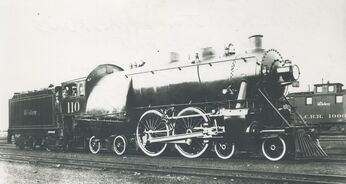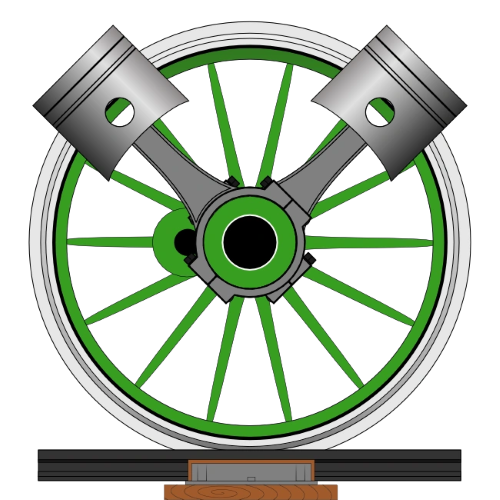The Whyte notation is a form of classification for steam locomotives,

A graphic of the Whyte notation, with the wheel-arrangement shown being a 4-8-4. (Four leading wheels, eight drive wheels, and four trailing wheels.
(which is also the main form of classifying steam locomotive wheel arrangements) is a wheel arrangement classification developed by Frederick Whyte in the mid-1800s. The notation classifies different forms of steam locomotives, as well as distinguishing them from one another. There are also different nicknames for the different types and forms of wheel arrangements as well.
How to read Whyte notation
Whyte notation works by counting the wheels, and not the axles unlike the AAR and UIC classifications. Because of this, all the numbers in the Whyte notation are even and are never odd. There are 3-6 numbers in Whyte notation, separated by hyphens (-). The first number was always the leading wheels and the last number was always the trailing numbers. The 1-3 numbers in the center were the driving wheels, which moved the locomotive. A plus sign (+) between two groups of three numbers usually denotes that it is an articulated Garratt locomotive. A notation that contains 4 or 5 numbers is a Mallet articulated locomotive.
Problems
A few wheel arrangements can't be covered by the Whyte notation. This includes a Turkish arrangement that started out as a 2-6-0. But when a pair of carrying wheels were added to the design, between the central and rear driving axles to fix an axle load issue, it cannot be explained using the Whyte notation. Some steam locomotives, although rare, don't rest their driving wheels on the rails. This is also impossible to explain using the Whyte notation. The driving wheels rest atop other wheels. This was be done to try to multiply the power (or speed) of the locomotive, or to act like gearing. Such designs were not set into production by railroad (railway) companies. Either through cost, height or other factors such as axle weight, they weren't able to be used on most railroads (railways).
Wheel arrangements

An experimental 4-4-4 steam locomotive.
There are many different forms of wheel arrangements for steam locomotives, this is an incomplete list.
Such examples are:
Non-articulated types:
- 0-2-2
- 2-2-0 "Planet"
- 2-2-2 "Jenny Lind"
- 2-4-0 "Porter"
- 2-4-2 "Columbian"
- 4-2-0 "Jervis"
- 4-2-2
- 4-2-4 "Huntington"
- 6-2-0 "Crampton"
- 0-4-0 "Four-coupled"
- 0-4-2 "Olomana"
- 0-4-4 "Forney"
- 4-4-0 "American"
- 4-4-2 "Atlantic"
- 4-4-4 "Jubilee"
- 2-6-0 "Mogul"
- 2-6-2 "Prairie"
- 2-6-4 "Adriatic"
- 4-6-0 "Ten-wheeler"
- 4-6-2 "Pacific"
- 4-6-4 "Hudson" (Baltic on CMStP&P and in UK)
- 0-8-0 "Eight-coupled"
- 2-8-0 "Consolidation"
- 2-8-2 "Mikado" ("MacArthur" during WWII)
- 2-8-4 "Berkshire" (the Chesapeake & Ohio called them Kanawhas)
- 4-8-0 "Mastodon"
- 4-8-2 "Mountain" (Mohawk on NYC)
- 4-8-4 "Northern" and various other names for various railroads
- 6-8-6 "Turbine"
- 0-10-0 "Ten-coupled"
- 0-10-2 "Union"
- 2-10-0 "Decapod"
- 4-10-0 "El Gobernador"
- 4-10-2 "Overland"
- 2-10-2 "Santa Fe"
- 2-10-4 "Texas"
- 0-12-0
- 2-12-0
- 4-12-2 "Union Pacific" (unique to the actual railroad)
- 4-14-4 "AA20" (only one of its kind)
Duplex drive
- 2-4-6-2 (only used in France)
- 4-4-4-4 (only used by the Pennsylvania and Baltimore & Ohio Railroads)
- 4-4-6-4 (only used by the Pennsylvania Railroad)
- 4-6-4-4 (only used by the Pennsylvania Railroad)
- 6-4-4-6 (only used by the Pennsylvania Railroad)
Tenderless (tank engine) types:
Suffixes: "T": "side-tank", "ST": "saddle-tank" (considered to be a modification), "PT": "pannier-tank", "WT": "well-tank".
- 2-2-0T
- 2-2-2T
- 2-2-4T
- 0-4-0T
- 0-4-2T
- 0-4-4T
- 2-4-0T
- 2-4-2T
- 0-6-0T
- 0-6-2T
- 2-6-0T
- 2-6-2T
- 2-6-4T
- 2-6-6T
- 4-6-2T
- 4-6-4T
- 4-6-6T
- 0-8-0T
- 0-8-2T
- 0-8-4T
- 2-8-0T
- 2-8-2T
- 2-10-2T
- 2-10-4T
- 0-12-0T
- 2-12-2T
- 2-12-4T
Articulated Locomotives
Mallet Locomotives
- 0-2-2-0 "Mount Washington" (Cog railway is the only user of this type)
- 0-4-4-0 "BB II" (German)
- 2-4-6-2 (only used by the ATSF)
- 0-6-6-0 "Old Maude" (B&O)
- 0-8-8-0 "Angus"
- 2-6-6-2

Black Hills Central railroad 2-6-6-2ST (or 2-6-6-2T) No. 110, which is the last of its kind.
- 2-6-6-4 (only used by three railroads, most famously used on the Norfolk & Western)
- 2-6-6-6 "Allegheny/Blue Ridge" (Chesapeake & Ohio and the Virginian railroads were the only two railroad to own this actual type; the heaviest locomotive ever built[1][2])
- 4-6-6-2 MM-2 "Cab-forward" (from "AC Series" Southern Pacific cab forward steam locomotives; only railroad to own this type)
- 4-6-6-4 "Challenger" (UP 3985 is the only one of the largest steam locomotives to actually operate steam excursions as of today)
- 2-8-8-2 "Chesapeake" (first used by the Chesapeake & Ohio and made famous by the Norfolk & Western, the last articulated steam locomotive to be built)
- 2-8-8-4 "Yellowstone" (first used by the Northern Pacific and made famous by the Duluth Missabe & Iron Range, the third heaviest and the locomotive that pulled the heaviest trains)
- 4-8-8-2 AC-4-12 "Cab Forward" (later AC series cab forward steam locomotives; the fourth heaviest steam locomotive ever built and the only surviving cab forward in North America.
- 4-8-8-4 "Big Boy" Originally "Wasatch"; unique to Union Pacific; 2nd heaviest steam locomotive ever [1][2]
- 2-10-10-2 "Santa Fe"; unique to ATSF and Virginian; longest steam locomotives ever
- 2-8-8-8-2 "Triplex" (Erie railroad; three steam locomotives ever built with the most wheels)
- 2-8-8-8-4 "Triplex" (Virginian railroad; one of the steam locomotives ever built with the most wheels)
- 2-8-8-8-8-2 (only a concept)
- 2-8-8-8-8-8-2 (only a concept)
- 2-10-10-10-10-10-2 (only a concept)
Meyer
- 0-4-0+0-4-0
- 0-6-2+0-6-2
- 0-6-0+0-6-0
Garratt
- 0-4-0+0-4-0
- 0-6-0+0-6-0
- 2-6-0+0-6-2
- 2-6-2+2-6-2
- 4-6-2+2-6-4
- 2-8-2+2-8-2
- 2-8-4+4-8-2
- 4-8-2+2-8-4
- 4-8-0+4-8-4 (C&O M-1 steam turbine)
- 4-8-4+4-8-4
- 2-6-6-2+2-6-6-2 (only a concept)
